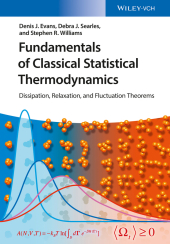 Neuerscheinungen 2016Stand: 2020-02-01 |
Schnellsuche
ISBN/Stichwort/Autor
|
Herderstraße 10
10625 Berlin
Tel.: 030 315 714 16
Fax 030 315 714 14
info@buchspektrum.de |

Denis J. Evans, Debra J. Searles, Stephen Rodney Williams
(Beteiligte)
Fundamentals of Classical Statistical Thermodynamics
Dissipation, Relaxation and Fluctuation Theorems
1. Auflage. 2016. XIV, 205 S. 100 SW-Abb. 244 mm
Verlag/Jahr: WILEY-VCH 2016
ISBN: 3-527-41073-2 (3527410732)
Neue ISBN: 978-3-527-41073-6 (9783527410736)
Preis und Lieferzeit: Bitte klicken
Both a comprehensive overview and a treatment at the appropriate level of detail, this textbook explains thermodynamics and generalizes the subject so it can be applied to small nano- or biosystems, arbitrarily far from or close to equilibrium. In addition, nonequilibrium free energy theorems are covered with a rigorous exposition of each one. Throughout, the authors stress the physical concepts along with the mathematical derivations.
For researchers and students in physics, chemistry, materials science and molecular biology, this is a useful text for postgraduate courses in statistical mechanics, thermodynamics and molecular simulations, while equally serving as a reference for university teachers and researchers in these fields.
1 INTRODUCTION
2 INTRODUCTION TO TIME-REVERSIBLE, THERMOSTATTED DYNAMICAL SYSTEMS, AND STATISTICAL MECHANICAL ENSEMBLES
2.1 Time Reversibility in Dynamical Systems
2.2 Introduction to Time-Reversible, Thermostatted Dynamical Systems
2.3 Example: Homogeneously Thermostatted SLLOD Equations for Planar Couette Flow
2.4 Phase Continuity Equation
2.5 Lyapunov Instability and Statistical Mechanics
2.6 Gibbs Entropy in Deterministic Nonequilibrium Macrostates
2.A Appendix: Phase Space Expansion Calculation
3 THE EVANS-SEARLES FLUCTUATION THEOREM
3.1 The Transient Fluctuation Theorem
3.2 Second Law Inequality
3.3 Nonequilibrium Partition Identity
3.4 Integrated Fluctuation Theorem
3.5 Functional Transient Fluctuation Theorem
3.6 The Covariant Dissipation Function
3.7 The Definition of Equilibrium
3.8 Conclusion
4 THE DISSIPATION THEOREM
4.1 Derivation of the Dissipation Theorem
4.2 Equilibrium Distributions are Preserved by Their Associated Dynamics
4.3 Broad Characterization of Nonequilibrium Systems: Driven, Equilibrating, and T-Mixing Systems
5 EQUILIBRIUM RELAXATION THEOREMS
5.1 Introduction
5.2 Relaxation toward Mixing Equilibrium: The Umbrella Sampling Approximation
5.3 Relaxation of Autonomous Hamiltonian Systems under T-Mixing
5.4 Thermal Relaxation to Equilibrium: The Canonical Ensemble
5.5 Relaxation to Quasi-Equilibrium for Nonergodic Systems
5.6 Aside: The Thermodynamic Connection
5.7 Introduction to Classical Thermodynamics
5.A Appendix: Entropy Change for a Cyclic Temperature Variation
6 NONEQUILIBRIUM STEADY STATES
6.1 The Physically Ergodic Nonequilibrium Steady State
6.2 Dissipation in Nonequilibrium Steady States (NESSs)
6.3 For T-Mixing Systems, Nonequilibrium Steady-State Averages are Independent of the Initial Equilibrium Distribution
6.4 In the Linear Response Steady State, the Dissipation is Minimal with
Respect to Variations of the Initial Distribution
6.5 Sum Rules for Dissipation in Steady States
6.6 Positivity of Nonlinear Transport Coefficients
6.7 Linear Constitutive Relations for T-Mixing Canonical Systems
6.8 Gaussian Statistics for T-Mixing NESS
6.9 The Nonequilibrium Steady-State Fluctuation Relation
6.10 Gallavotti-Cohen Steady-State Fluctuation Relation
6.11 Summary
7 APPLICATIONS OF THE FLUCTUATION, DISSIPATION, AND RELAXATION THEOREMS
7.1 Introduction
7.2 Proof of the Zeroth "Law" of Thermodynamics
7.3 Steady-State Heat Flow
7.4 Dissipation Theorem for a Temperature Quench
7.5 Color Relaxation in Color Blind Hamiltonian Systems
7.6 Instantaneous Fluctuation Relations
7.7 Further Properties of the Dissipation Function
8 NONEQUILIBRIUM WORK RELATIONS, THE CLAUSIUS INEQUALITY, AND EQUILIBRIUM THERMODYNAMICS
8.1 Generalized Crooks Fluctuation Theorem (GCFT)
8.2 Generalized Jarzynski Equality (GJE)
8.3 Minimum Average GeneralizedWork
8.4 NonequilibriumWork Relations for CyclicThermal Processes
8.5 Clausius´ Inequality, the Thermodynamic Temperature, and Classical Thermodynamics
8.6 Purely Dissipative GeneralizedWork
8.7 Application of the Crooks Fluctuation Theorem (CFT), and the Jarzynski Equality (JE)
8.8 Entropy Revisited
8.9 For Thermostatted Field-Free Systems, the Nonequilibrium Helmholtz Free Energy is a Constant of the Motion
9 CAUSALITY
9.1 Introduction
9.2 Causal and Anti-causal Constitutive Relations
9.3 Green-Kubo Relations for the Causal and Anti-causal Response Functions
9.4 Example: The Maxwell Model of Viscosity
9.5 Phase Space Trajectories for Ergostatted Shear Flow
9.6 Simulation Results
9.7 Summary and Conclusion


